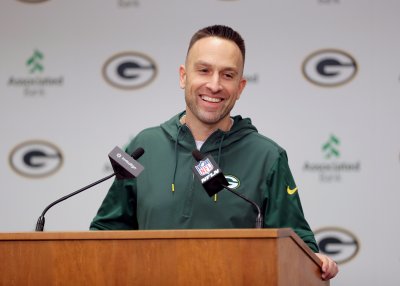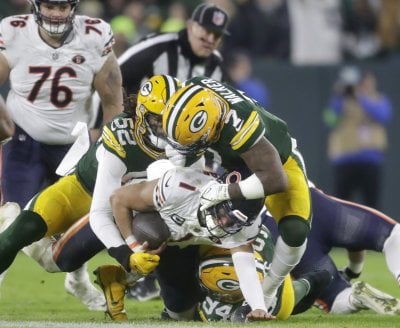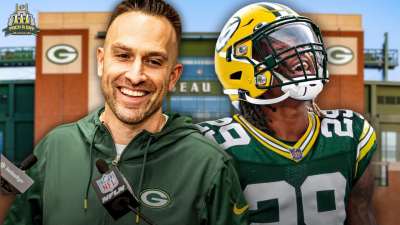Cheesehead TV Matchup: Week One
By PackerAaron
Offense:
Much has been made of the fact that the Packers spent a lot of time working the edges the last time these two teams met, with Ryan Grant running a wide variety of stretch and pitch plays on his way to becoming the only back to gain over 100 yards against the Vikings last season. While 'working the edges' will remain a focus (to attempt to run inside against the Williams' is folly, save for the occasional draw play) the real keys on offense come in two separate areas for the Packers.
- Personnel Groupings and Formations In the Running Game
Much more than the designs of the runs themselves, the personnel on the field and the way they are aligned at the snap of the ball will have a huge amount to do with how the Packers crack the vaunted Viking run defense. Last year, McCarthy used a wide range of personnel groupings and formations to create favorable matchups for the Packers offense both on the ground and in the air. A good example of this is on Ryan Grant's touchdown run. The Packers come out in base personnel (two wide receivers, two backs, one tight end) but group them in an extremely tight formation. Tight End Donald Lee is upright, just off the line and tackle Mark Tauscher. He and Fullback Korey Hall are the keys to the play. Lee slams down on the left defensive end, allowing Tauscher to pull (funnily enough, Tauscher finds no one to hit) while Hall, having come in motion across the formation, takes out the middle linebacker at the point of attack. Running back Ryan Grant does the rest. It's a complicated looking play, due to all the bodies slamming around inside and the sweep motion to the right, but in reality, almost 18 of the 22 players on the field are inconsequential. The entire play rests in the hands of Lee, Hall and Grant. That's what McCarthy needs to do in the run game on Monday night. Eliminate the matchups that favor the Vikings and work to isolate players he feels can win the one on ones they are presented with.
- McCarthy's Resolve
Mike McCarthy has stated again and again that Aaron Rodgers will run the same offense Brett Favre ran last year. Some tweaks have been made, we are told, but the responsibilities remain the same. McCarthy needs to be true to his word and let Rodgers run the offense, no matter how the first 10 minutes of the game go. Rodgers has to be free to make mistakes. He will and he will learn from them. But if McCarthy jumps ship at the first sign of trouble for his new starting quarterback, (and I don't think he will) it will send all sorts of signals not only to Rodgers but to all the remaining teams on the Packers schedule. Rodgers will have his swings, both in this game and during the season. McCarthy needs to ride those out. One way he can help is with a liberal use of two tight end formations, with two backs, either in the offset I or Splits, plus a lot of bunch formations when the Packers have multiple wideouts on the field. Much more of what we saw the opening drive against Denver rather than the spread out formations we saw against the 49ers. Now, I'm not saying "Don't spread them out" - far from it. But for every formation that the Offense has it's receivers split out past the hashmarks, McCarthy should run two or three tight packages and have a play that motions out of them. Use Rodgers' athleticism to get him in a position to be successful early. This will not only boost the young signal caller's confidence, but it will help keep the Vikings defense guessing as to where and how to send pressure at the first time starter. It's easy to blitz when you know exactly where the QB will be every play. It's much harder when the quarterback is constantly on the move. Sure, they might hit on one now and then, but more often than not the Vikings desire to throw the kitchen sink at Rodgers can be used to exploit one on one matchups that favor the Packers' deep recieving corps.
DEFENSE
- Don't Let Tarvaris Jackson Get Comfortable Early
Most Game Previews for this game will no doubt start with 'Stopping Adrian Peterson' for the Packers defense. And while I agree, I think the Packers demonstrated the ability to contain Peterson in last season's second matchup at Lambeau. Peterson never broke off a run longer than 12 yards before going down with an injury. Now, one reason for this was the Packers disciplined play of defense. But a bigger reason was that Viking quarterback Brooks Bollinger could not exploit any one on one matchup he found down field, despite there being several opportunities to do so. And for all the guff that I've given Tarvaris Jackson (and those that support him as an emerging player) he is most certainly NOT Brooks Bollinger. In fact, with the threat of Peterson behind him, he is on the cusp of becoming a dangerous quarterback. Brad Childress will look to not only set up the play-action game, but he will try to get Jackson outside the pocket and limit his reads to one side of the field. Bob Sanders simply can not allow this to happen. For all the attention Peterson gets and will get Monday night, Sanders simply must find a way to rattle Jackson early. His biggest deficiency up to this point in his pro career has been his inability to handle pressure. If the Packers attack him early, with a wide array of blitzes, they can ensure he'll be seeing ghosts for the rest of the game. But if they come out in their base 4-3 and let the Vikings march down the field, Jackson will not only find his rhythm early, he will make it near impossible for Sanders to guess right later in the game as to what to call defensively.
PLEASE SUBSCRIBE TO OUR CHEESEHEAD NATION WEEKLY NEWSLETTER HERE.
__________________________











